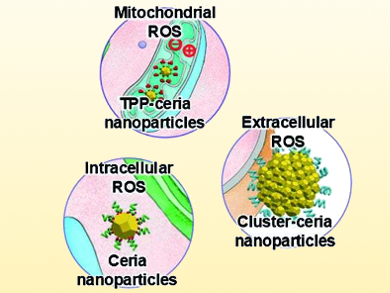Reactive oxygen species (ROS) cause oxidative stress in living tissue and are important in the development of many diseases. However, no method has been reported to date that can remove the ROS based on their locations in or around cells. Such a method could help to improve the understanding of the pathological effects of ROS.
Taeghwan Hyeon, Institute for Basic Science (IBS) and Seoul National University, both Seoul, Republic of Korea, and colleagues have developed three different kinds of ceria nanoparticles (pictured) to address this problem. The ceria nanoparticles can be easily taken up by cells and remove intracellular ROS through catalytic reactions. If triphenylphosphonium (TPP) is conjugated onto the ceria nanoparticles, they can penetrate even further into the mitochondria of the cells and eliminate ROS there. When the ceria nanoparticles are assembled into nanoparticle clusters, their cellular uptake is inhibited because of their large size and only extracellular ROS are scavenged.
The therapeutic effects of these ceria nanoparticles were evaluated using a mouse model of Parkinson’s disease. The data showed reduced levels of neurodegeneration, neuroinflammation, and oxidative damage in the mouse brains treated with the ceria or TPP-conjugated ceria nanoparticles. These results indicate that intracellular and mitochondrial ROS can be considered as a treatment target for Parkinson’s therapy. According to the researchers, the developed nanoparticle systems could be a useful tool for studying the effects of various ROS in diseases.
- Ceria Nanoparticle Systems for Selective Scavenging of Mitochondrial, Intracellular, and Extracellular Reactive Oxygen Species in Parkinson’s Disease,
Hyek Jin Kwon, Dokyoon Kim, Kyungho Seo, Young Geon Kim, Sang Ihn Han, Taegyu Kang, Min Soh, Taeghwan Hyeon,
Angew. Chem. Int. Ed. 2018.
https://doi.org/10.1002/anie.201805052




